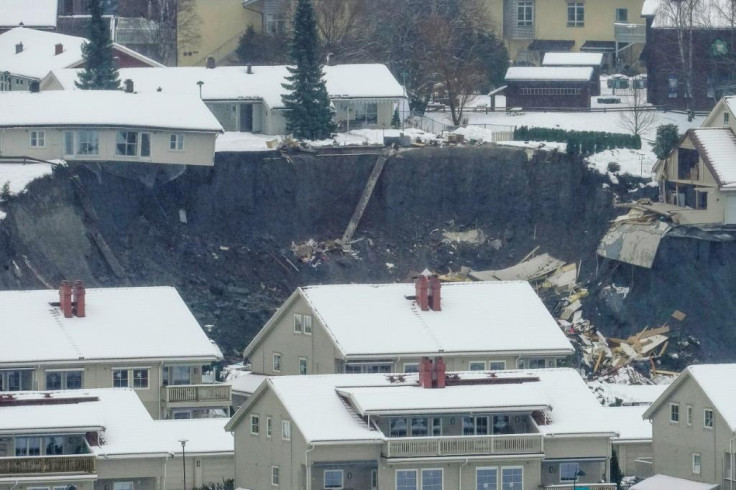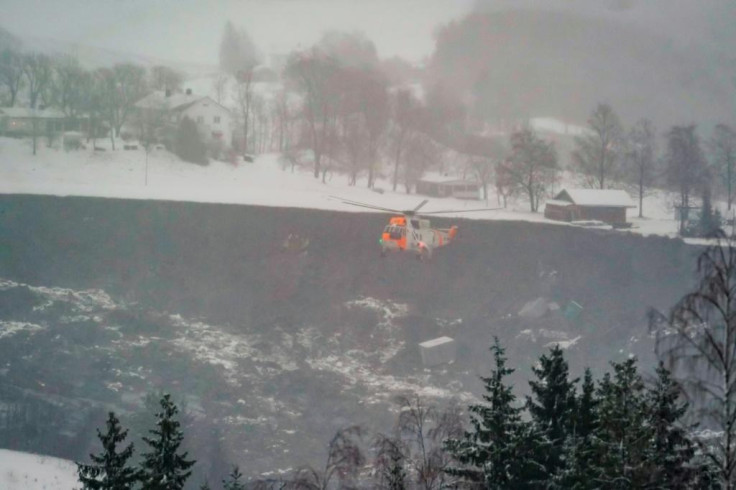Norway landslide buries homes, 11 missing
According to the Norwegian Water Resources and Energy Directorate (NVE) what happened was a so-called "quick clay slide" of approximately 300 by 700 metres (328 to 766 yards).
A major landslide destroyed homes overnight in a village in Norway close to the capital Oslo, leaving at least 11 people unaccounted for and 10 injured, police and local media said Wednesday.
Video footage from the scene showed a whole hillside had collapsed in Ask, in the municipality of Gjerdrum, 25 kilometres (15 miles) northeast of the capital. Homes were left crushed and buried in dark mud.
Snow fell throughout the morning as the emergency services evacuated the injured and attempted to secure those homes still standing. Some houses had been left teetering on the edge of the crater left behind by the slide, with a few falling over the edge as the day went on.
Norway's Prime Minister Erna Solberg, who travelled to the village of around 1,000 people on Wednesday, described the landslide as "one of the largest" the country had seen.
"It's a dramatic experience to be here," Solberg told reporters, expressing particular concern for those still missing.
"The situation is still so unstable with the mud that it's not yet possible to do anything other than helicopter rescues," she added.

Norwegian media said that 700 people had been evacuated from their homes, and the municipality warned as many as 1,500 could need to leave the region out of safety concerns.
Around 8 pm (1900 GMT) police said 11 people were still unaccounted for, based on residents registered in the area, with some of the missing being children.
"We believe that there are people in that landslide area, but whether it is the 11 or fewer we can not determine with certainty," chief of operations Roger Pettersen told broadcaster NRK.
In a statement published online, police also stressed that the figure was uncertain and could both go down and up as they were unsure of any visitors had been in the homes.
The search would continue overnight as police were using helicopters and drones equipped with thermal cameras.

Police said 10 people were injured, with one transferred to Oslo with serious injuries.
"Police are designating this as a disaster,"Pettersen told broadcaster NRK earlier in the day.
Emergency calls had come in from people saying their whole house was moving, he said.
"There are dramatic reports and the situation is serious," Pettersen said.
According to the Norwegian Water Resources and Energy Directorate (NVE) what happened was a so-called "quick clay slide" of approximately 300 by 700 metres (328 to 766 yards).
"This is the largest landslide in recent times in Norway, considering the number of houses involved and the number of evacuees," NVE spokeswoman Laila Hoivik told AFP.
Quick clay is a sort of clay found in Norway and Sweden that can collapse and turn to fluid when overstressed.
"The area has been surveyed earlier, and is known to contain quick clay. The possibility of similar large slides in the area is low at the moment," Hoivik said.
Swedish daily Aftonbladet reported that Sweden was sending specially trained personnel to help in the rescue effort.
"We will help in the search for missing people and securing buildings," operations leader Stefan Karlsson of the Gothenburg emergency services, told the newspaper.
Norway's king Harald said in a statement that the accident had "made a deep impression on me and my family.
"My thoughts are with everyone affected, the injured, those who lost their homes and are now living in fear and uncertainty of the full extent of the disaster," he said.
Copyright AFP. All rights reserved.
This article is copyrighted by International Business Times, the business news leader





















